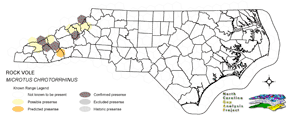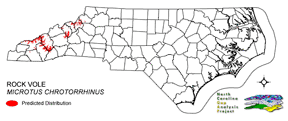
| Taxa: |
| Order: |
| Family: |
| Mammalia |
| Rodentia |
| Muridae |
| NatureServe Global Rank: |
| NatureServe State (NC) Rank: |
| G4 |
| S2 |
| Federal Status: |
| NC State Status: |
| --- |
| --- |


| Land Unit |
| US Fish & Wildlife Service |
| US Forest Service |
| US National Park Service |
| US Department of Defense |
| NC State Parks |
| NC University System |
| NC Wildlife Res. Com. |
| NC Forest Service |
| NC Div. of Coastal Mgmt. |
| Local Governments |
| Non-Governmental Org. |
| Other Public Lands |
| Private Lands |
| GAP Status 1-2 |
| All Protected Lands |
| Statewide |
| Hectares |
| 0.00 |
| 42,630.30 |
| 0.00 |
| 46,766.61 |
| 599.04 |
| 0.00 |
| 500.49 |
| 0.00 |
| 0.00 |
| 2,742.84 |
| 3,772.80 |
| 0.00 |
| 53,569.53 |
| 59,862.42 |
| 96,951.78 |
| 150,581.61 |
| Acres |
| 0.00 |
| 105,341.74 |
| 0.00 |
| 115,562.79 |
| 1,480.26 |
| 0.00 |
| 1,236.74 |
| 0.00 |
| 0.00 |
| 6,777.70 |
| 9,322.79 |
| 0.00 |
| 132,373.17 |
| 147,923.23 |
| 239,573.02 |
| 372,095.19 |
| % of Dist. on |
| Prot. Lands |
| 0.0 % |
| 44.0 % |
| 0.0 % |
| 48.2 % |
| 0.6 % |
| 0.0 % |
| 0.5 % |
| 0.0 % |
| 0.0 % |
| 3.8 % |
| 3.8 % |
| 0.0 % |
| 0.0 % |
| 61.7 % |
| ----- |
| ----- |
| % of Dist. on |
| All Lands |
| 0.0 % |
| 28.3 % |
| 0.0 % |
| 31.1 % |
| 0.4 % |
| 0.0 % |
| 0.3 % |
| 0.0 % |
| 0.0 % |
| 1.8 % |
| 2.5 % |
| 0.0 % |
| 35.6 % |
| 39.8 % |
| ----- |
| ----- |
|
Usually uncommon in abundance, the rock vole inhabits mountain forests of the Appalachians south to Tennessee and North Carolina (Lee et al. 1982, Whitaker and Hamilton 1998). In North Carolina, the species is rare at most localities where it has been found, but locally common in the Great Smoky Mountains (Lee et al. 1982, Clark 1987). The vole is found in cool, moist mountain forest settings, but also among high summit rock outcrops and in upper elevation grassy meadows and heath balds (Whitaker and Hamilton 1998). The vole is considered by some authors to mainly inhabit conifer forests (Lee et al. 1982). However, Linzey and Linzey (1971) indicates a number of collection locations where northern hardwoods dominate. D.W. Pfitzer noted, from a survey in the Great Smoky Mountains NP, that three habitat types are used; very rocky talus slopes with no grass, open grassy areas, and one location where a specimen was taken in birch-beech forest (Linzey and Linzey 1971). Therefore, at mid and high-elevations in the southern Appalachians, the species may be more limited by the availability of suitable shelter than by forest type. High-mountain streams with varying amounts of surface rock are also noted as suitable habitat (Linzey and Linzey 1971). It prefers retreats in boulder and talus fields or log-fall areas in shaded, moist to damp forest settings. Moss-covered rock piles and logs, rock crevices, and thick leaf litter among rocks appear to be preferred denning sites (Webster et al. 1985, Whitaker and Hamilton 1998). However, it also inhabits more open sites, such as mountain meadows and balds, where suitable rocky shelter is present. It also can be found in brush and slash piles of cutover areas. NATURE SERVE GLOBAL HABITAT COMMENTS: Cool, damp, coniferous and mixed forests at higher elevations in the Appalachians; mossy rocky areas throughout Canada. Optimal habitat: ferns/mossy debris near flowing water in coniferous forests. Also occupies deciduous forest/spruce clearcuts (mainly recent cuts), forest ecotones, grassy balds near forest, and sterile-looking rocky road fills. Occupies shallow burrows and runways. Nests probably are placed under logs or in similar protected sites. They are made of moss with a lining of grass and have multiple entrance tunnels. 'Sphagnum moss is frequently pulled off in clumps where rock voles are found...,' presumably for use in nest building (Martin 1971). Although rock voles have been trapped in a variety of habitats, they typically occur in moist talus or among mossy rocks and logs in spruce and northern hardwood forests. Overstory is most commonly red spruce (PICEA RUBENS), often with birches (BETULA spp.), poplar and aspen (POPULUS spp.), other northern hardwoods, or fir (ABIES BALSAMEA). In the Appalachians, the forest is often birch, various other hardwoods and hemlock (TSUGA CANADENSIS). Ground cover characteristically includes an abundance of mosses, ferns, and northern herbs and subshrubs such as bunchberry (CORNUS CANADENSIS), blueberry (VACCINIUM spp.), Canada mayflower (MAIANTHEMUM CANADENSE), blue-bead lily (CLINTONIA BOREALIS), star-flower (TRIENTALIS BOREALIS), and Labrador tea (LEDUM GROENLANDICUM). Other habitats include unvegetated talus, grass balds, recent clearcuts, and roadfills, but these sites have dense vegetation nearby. There is usually a stream or other surface water in the immediate vicinity, but Martin (1971) speculated that fog intercepted by rocks and vegetation may be an important source of drinking water in some localities, such as coastal Labrador. Moist situations are clearly favored, as are higher elevations. Martin (1971) thought that records from atypical habitat may represent expansion of populations under favorable conditions. These might also be dispersing individuals. Fecal pellets are deposited in special latrine areas. Martin (1971) found a latrine, 50 cm in diameter and 24 cm deep, in a rock crevice. |
| Code | Name | Description | NC Natural Heritage Program Equivalent |
| 517 | Hemlock Floodplain Forest | Alluvial forest with hemlock and/or white pine in mountains and western piedmont. Hydrology is generally temporarily to seasonally flooded. | Canada Hemlock Forest |
| 521 | Spruce/Fir Forest | High Elevation Frazer-Fir - Red Spruce, Red Spruce and Red-Spruce-Yellow Birch Forests. Tree densities included here include both woodland to forest density. Highly intermixed with Northern Hardwoods, Grassy Balds, and Shrub Balds. | Red Spruce--Fraser Fir Forest, Fraser Fir Forest |
| 522 | Northern Hardwoods | High Elevation forests including yellow birch, American beech, and yellow buckeye. Includes forests with Hemlock and Yellow Birch. | Northern Hardwoods Forest, Boulderfield Forest |
| 523 | Grassy Bald | High Elevation grassy balds including Pennsylvania sedge, mountain oatgrass, as well as shrubby areas dominated by Alleghany and smooth blackberry. | Grassy Bald |
| 524 | Shrub Bald | Variable phenologies, predominantly evergreen balds with rhododendon and Mountain laurels. Deciduous shrubs including green alder and Alleghany and smooth blackberry are included as well. Red Oak - Chestnut Oak Woodlands may be included in cases where the density of the woodland species is low and the shrub component is dense. | Heath Bald |
| 525 | Appalachian Oak Forest | A variety of oak forest types including Black, White, Scarlet Oaks in dry to mesic situations. Includes forests historically co-dominated by American Chestnut. | High Elevation Red Oak Forest, Montane White Oak Forest |
| 526 | Appalachian Cove Forest | Mixed Mesophytic forests of the mountains. Includes tuliptree, basswood, yellow buckeye and surgar maple. This class is mapped to include cove forests dominated or co-dominated by hemlock. | Rich Cove Forest, Acidic Cove Forest |
| 527 | Appalachian Hemlock | Upland hemlock forests of the moutains region. Vary from side slopes to steep slope positions. | Canada Hemlock Forest |
| 535 | Talus/Outcrops/Cliffs | Includes seep talus slopes with sparce vegetation, as well as outcrops including, granitic outcrops. Some outcrops will have been mapped as barren rock. | No equivalent |
|
Kirkland, G. L. Jr., and F. J. Jannett Jr. 1982. MICROTUS CHROTORRHINUS. Am. Soc. Mamm., Mammalian Species No. 180. 5 pp.
Jones, J. K., Jr., et al. 1992. Revised checklist of North American mammals north of Mexico, 1991. Occas. Pap. Mus., Texas Tech Univ. (146):1-23. Wilson, D. E., and D. M. Reeder (editors). 1993. Mammal Species of the World:a Taxonomic and Geographic Reference. Second Edition. Smithsonian Institution Press, Washington, DC. xviii + 1206 pp. Whitaker, J.O. Jr. and W.J. Hamilton, Jr. 1998. Mammals of the eastern United States. Cornell Univ. Press, Ithaca, New York. 583 pp. Martin, R.L. 1971. THE NATURAL HISTORY AND TAXONOMY OF THE ROCK VOLE, MICROTUS CHROTORRHINUS. PH.D. THESIS, UNIVERSITY OF CONN. STORRS. 123 PP. Lee, D. S., L. B. Funderburg Jr., and M. K. Clark. 1982. A distributional survey of North Carolina mammals. Occasional Papers of the North Carolina Biological Survey, No. 1982-10. North Carolina State. Mus. Nat. Hist., Raleigh, North Carolina. 72 pp. Moore, D. W., and L. L. Janecek. 1990. Genic relationships among North American MICROTUS (Mammalia:Rodentia). Ann. Carnegie Mus. 59:249-259. Linzey, Alicia V., & Donald W. Linzey. 1971. Mammals of the Great Smoky Mountains National Park. The University of Ten- nessee Press, Knoxville, Tennessee. 114 p. Clark, M. K. (ed.). 1987. Endangered, threatened, and rare fauna of North Carolina, part I. A re-evaluation of the mammals. Occas. Pap. North Carolina Biol. Banfield, A.W.F. 1974. The mammals of Canada. University of Toronto Press, Toronto. Godin, A.J. 1977. Wild Mammals of New England. Johns Hopkins University Press, Baltimore. 304 pp. Hamilton, William J., Jr., and John O. Whitaker, Jr. 1979. Mammals of the eastern United States. Cornell Univ. Press, Ithaca, New York. 346 pp. Hall, E. R. 1981. The Mammals of North America. Second edition. 2 Volumes. John Wiley and Sons, New York, New York. Baker, Rollin H. 1983. Michigan mammals. Michigan State University Press. 642 pp. Tamarin, R. H., editor. 1985. Biology of New World MICROTUS. American Soc. Mamm. Special Publication (8):1-893. Webster, W. D., J. F. Parnell and W. C. Biggs Jr. 1985. Mammals of the Carolinas, Virginia, and Maryland. The University of North Carolina Press, Chapel Hill, NC. Handley, C. O., Jr. 1991. Mammals. Pages 539-616 in K. Terwilliger, coordinator. Virginia's endangered species:proceedings of a symposium. McDonald and Woodward Publishing Company, Blacksburg, Virginia. |
For more information please contact them at:
NC-GAP Analysis Project
Dept. of Zoology, NCSU
Campus Box 7617
Raleigh, NC 27695-7617
(919) 513-2853
www.basic.ncsu.edu/ncgap